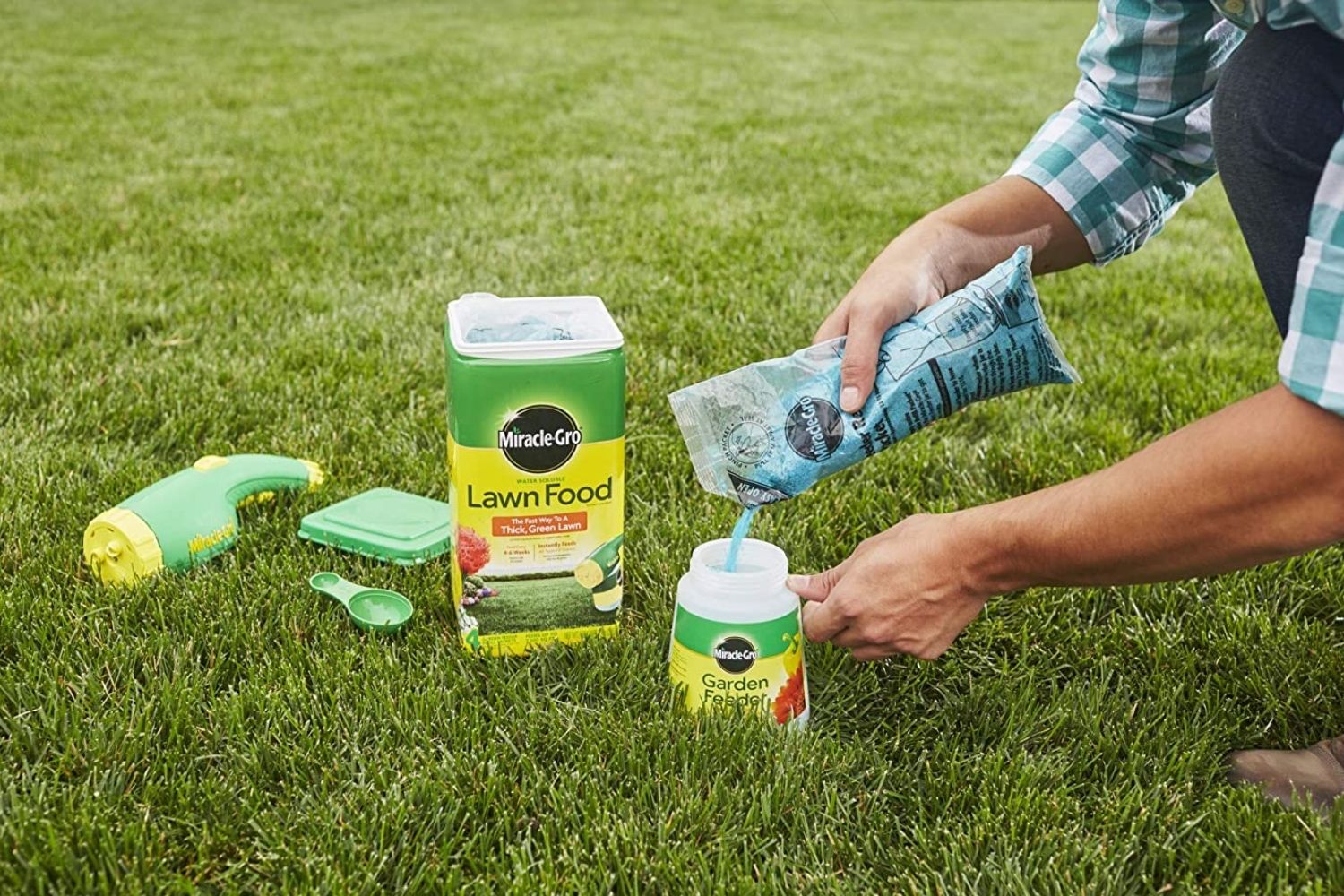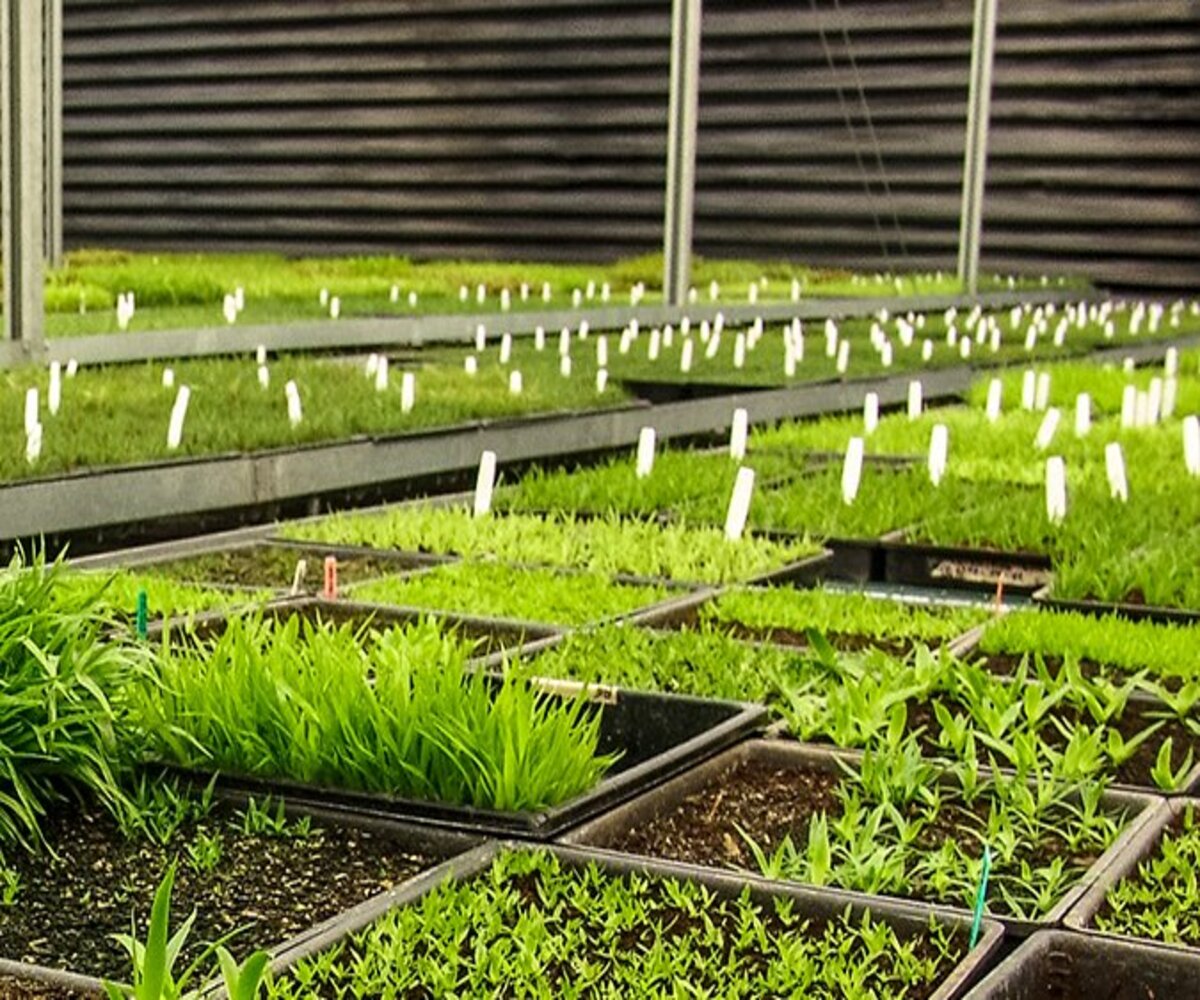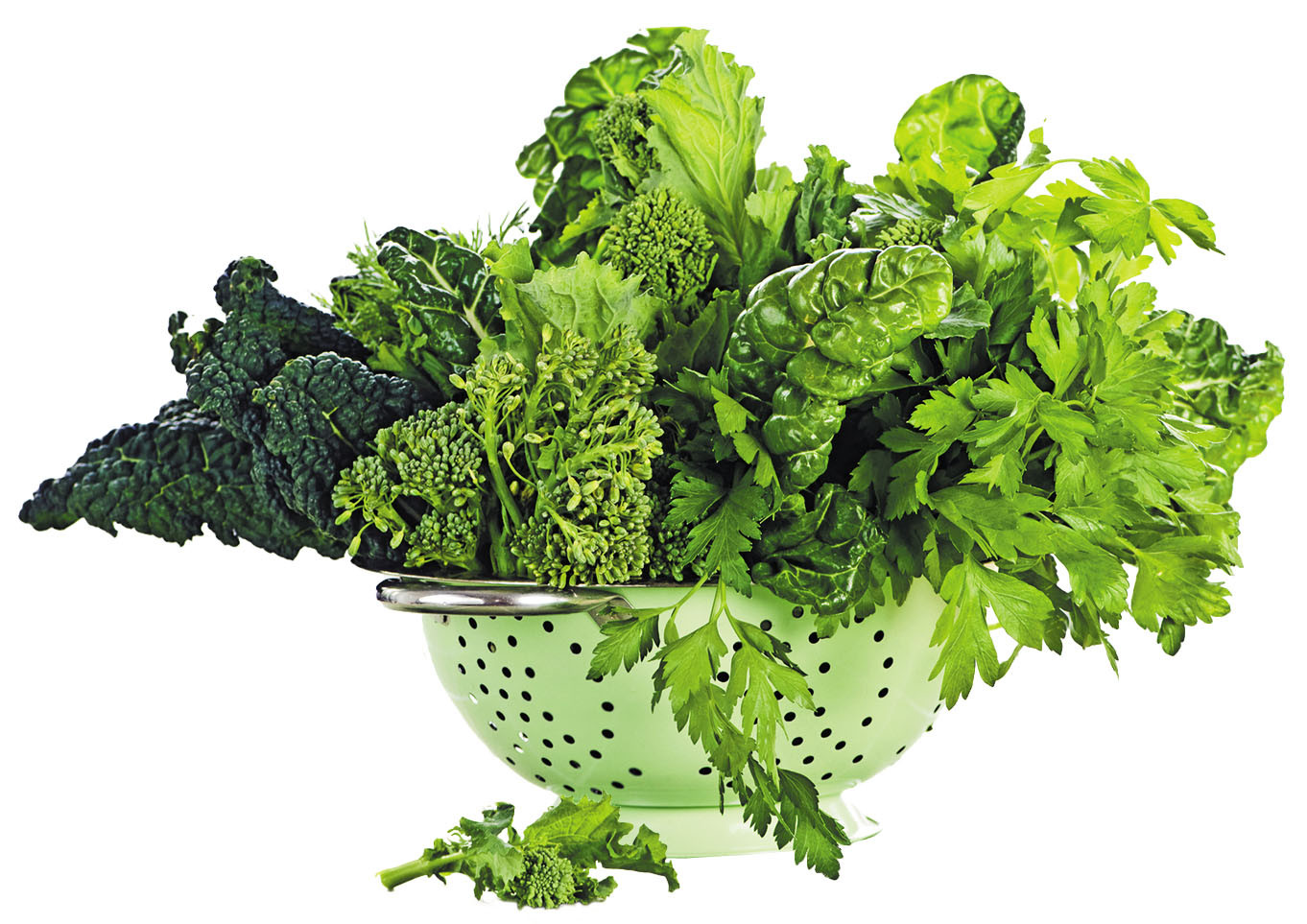Home>Gardening News and Trends>What Fertilizer Makes Grass Green


Gardening News and Trends
What Fertilizer Makes Grass Green
Modified: February 10, 2024
Discover the latest news on which fertilizer makes grass green and achieve a vibrant lawn. Explore effective tips and expert recommendations for lush, healthy turf.
(Many of the links in this article redirect to a specific reviewed product. Your purchase of these products through affiliate links helps to generate commission for Chicagolandgardening.com, at no extra cost. Learn more)
Table of Contents
- Introduction
- Understanding the Importance of Fertilizers for Green Grass
- Nitrogen-based Fertilizers and their Impact on Grass Color
- Phosphorus-based Fertilizers and their Role in Grass Greenness
- Potassium-based Fertilizers and their Effect on Grass Color
- Organic Fertilizers and their Contribution to Green Grass
- Choosing the Right Fertilizer for Your Lawn
- Application and Maintenance Tips for Green Grass
- Conclusion
Introduction
Welcome to the world of vibrant green lawns! Nothing beats the sight of lush, healthy grass carpeting our outdoor spaces. Whether it’s a sprawling backyard or a small patch of green in front of your house, a well-maintained lawn can instantly elevate the overall aesthetics of your property. But have you ever wondered what makes grass so beautifully green?
One of the essential factors in achieving and maintaining a vibrant green lawn is the use of fertilizers. Fertilizers provide the necessary nutrients that grass needs to thrive, ensuring its color remains vivid and vibrant throughout the year. But not all fertilizers are created equal; different types can have varying impacts on the color and health of your grass.
In this article, we’ll explore the different types of fertilizers and their specific contributions to the greenness of your grass. From nitrogen-based fertilizers to phosphorus-based and potassium-based ones, we’ll delve into the unique effects of each. We’ll also discuss the role of organic fertilizers in promoting green grass growth.
Whether you’re a seasoned gardener or a novice looking to improve your lawn care skills, this article will provide valuable insights into selecting the right fertilizer for your grass and maintaining its green color. So strap on your gardening gloves and let’s dig into the world of grass fertilizers!
Understanding the Importance of Fertilizers for Green Grass
When it comes to achieving a vibrant green lawn, fertilizers play a crucial role. They provide essential nutrients that grass needs to grow and maintain its color. Without the right balance of nutrients, your grass may become dull, yellow, and lackluster.
One of the key nutrients that fertilizers provide is nitrogen. Nitrogen is responsible for promoting healthy leaf growth, vibrant green color, and overall plant vigor. It is an essential component of chlorophyll, the pigment that gives plants their green color and is crucial for photosynthesis, the process that enables plants to convert sunlight into energy.
In addition to nitrogen, other essential nutrients for green grass include phosphorus and potassium. Phosphorus aids in root development and promotes the growth of strong, healthy grass that can withstand environmental stresses. It also plays a vital role in flower production and seed germination.
Potassium, on the other hand, helps to maintain overall plant health and strength. It enhances the grass’s ability to resist diseases, pests, and environmental challenges, such as drought and extreme temperatures. Potassium also plays a role in root development and helps with water uptake, making it an important component in achieving a healthy, green lawn.
Furthermore, organic matter in the soil serves as a reservoir of nutrients that grass can access. Organic matter helps to improve soil structure, moisture retention, and nutrient availability. It also enhances microbial activity, which aids in breaking down organic matter and releasing nutrients that are beneficial for grass growth.
While grass can absorb some nutrients naturally from the soil, it is often not enough to sustain optimal growth and vibrant color. This is where fertilizers come into play. They provide a concentrated and readily available source of essential nutrients, ensuring that your grass receives the necessary elements to flourish.
Keep in mind that different grass species have varying nutrient requirements. Understanding your specific grass type and its nutrient needs is essential for selecting the right fertilizer and achieving a healthy, green lawn. Conducting a soil test can also provide valuable insights into the existing nutrient levels in your soil and help guide your fertilizer choices.
By understanding the importance of fertilizers and the specific nutrients they provide, you can take proactive steps to ensure your grass remains vibrant, green, and healthy. In the following sections, we will explore the different types of fertilizers and their impact on grass color in more detail.
Nitrogen-based Fertilizers and their Impact on Grass Color
When it comes to enriching the greenness of your grass, nitrogen-based fertilizers are your go-to option. Nitrogen is the primary nutrient responsible for promoting vibrant leaf growth and enhancing the overall color of your lawn.
One of the main reasons why nitrogen is crucial for grass color is its role in chlorophyll production. Chlorophyll is the pigment that allows plants to harness sunlight and convert it into energy through photosynthesis. It also gives plants their characteristic green color. By supplying nitrogen to your grass, you are ensuring the production of an ample amount of chlorophyll, resulting in a brilliant green hue.
Nitrogen-based fertilizers come in different formulations, such as quick-release and slow-release. Quick-release fertilizers consist of nitrogen in a readily available form that is rapidly absorbed by the grass roots. These fertilizers provide an immediate boost to the grass’s color and growth. However, they require more frequent applications as the nutrients are used up relatively quickly.
On the other hand, slow-release nitrogen-based fertilizers provide a gradual and sustained supply of nutrients to the grass over an extended period. This allows for a more controlled release of nitrogen, ensuring a steady and prolonged color improvement. Slow-release fertilizers are ideal for reducing the frequency of fertilizer applications and maintaining a consistent green color throughout the growing season.
It is important to note that while nitrogen is beneficial for grass growth and color, excessive use of nitrogen-based fertilizers can lead to problems. Too much nitrogen can cause rapid, lush growth, making the grass more susceptible to disease, pests, and drought stress. It can also result in leaching of the excess nitrogen into water bodies, causing pollution.
To avoid these issues, it is crucial to follow the recommendations for fertilizer application rates and timings. Be sure to read the instructions provided by the manufacturer and adjust the application amount based on your specific grass type and local soil conditions. Additionally, consider incorporating organic matter into your soil, as it can enhance nutrient retention and reduce the risk of nitrogen runoff.
Nitrogen-based fertilizers are a powerful tool to achieve the vibrant green color of your grass. By understanding the impact of nitrogen on chlorophyll production and the proper application methods, you can optimize the greenness of your lawn and enjoy a stunning outdoor space all year round.
Phosphorus-based Fertilizers and their Role in Grass Greenness
While nitrogen is often the star of the show when it comes to enhancing grass color, phosphorus also plays a vital role in achieving and maintaining a vibrant green lawn. Phosphorus-based fertilizers are essential for promoting root development, which directly impacts the overall health and greenness of your grass.
Phosphorus is responsible for crucial processes within the plant, including energy transfer, photosynthesis, and the formation of DNA and RNA. By supplying phosphorus to your grass, you are supporting its metabolic activities and overall growth.
When it comes to grass greenness, phosphorus plays a particularly important role in root development. A strong and extensive root system allows the grass to access water and nutrients more effectively, leading to healthier and greener foliage above the ground.
In addition to promoting root growth, phosphorus-based fertilizers also play a role in flower and seed production. If you desire a lawn with beautiful blooms or wish to encourage your grass to reproduce, phosphorus is an essential nutrient to consider.
Phosphorus-based fertilizers are commonly available in granular or liquid form. The granular form is applied directly to the soil and is ideal for slow-release over time. The slow-release property ensures a consistent supply of phosphorus to the grass, promoting steady root development and greenness. On the other hand, liquid phosphorus fertilizers are fast-acting and are absorbed by the plant quickly. They provide an immediate boost of phosphorus to support rapid growth and development.
While phosphorus is crucial for grass greenness, it is essential to use phosphorus-based fertilizers judiciously. Excessive phosphorus can lead to nutrient imbalances and cause environmental issues. Before applying phosphorus-based fertilizers, it is advisable to conduct a soil test to determine the existing levels of phosphorus in your soil. This will help you adjust the application rates accordingly, avoiding potential harm to the environment and wasteful use of resources.
Overall, phosphorus-based fertilizers are an important component of lawn care for enhancing grass greenness. By supporting root development and overall metabolic activities, phosphorus ensures that your grass is equipped to capture nutrients and water effectively, resulting in a lush and green lawn.
Potassium-based Fertilizers and their Effect on Grass Color
When it comes to achieving and maintaining a vibrant green lawn, the role of potassium-based fertilizers cannot be overlooked. Potassium, also known as potash, is a vital nutrient that plays a significant role in enhancing grass color and overall plant health.
One of the primary functions of potassium is to regulate water uptake within the grass. It aids in the opening and closing of stomata, which are tiny openings on the surface of leaves that allow for gas exchange. By regulating stomata function, potassium helps the grass to retain water more efficiently, reducing the risk of drought stress and wilting. This, in turn, contributes to the vibrant green color of the grass.
Potassium also plays a critical role in photosynthesis, the process by which plants convert sunlight into energy. It is involved in the production and transport of sugars, which fuel the growth and development of the grass. Additionally, potassium helps to strengthen the grass cell walls, promoting sturdy and robust plant structures.
Another important aspect of potassium is its ability to improve overall plant health and resistance to diseases and pests. A well-nourished grass, enriched with potassium, is better equipped to ward off common lawn problems and environmental stresses. This includes resistance to disease pathogens, pests, and extreme temperatures.
Potassium-based fertilizers are typically available in granular form and can be applied to the soil surface. These fertilizers slowly release potassium over time, ensuring a steady supply of nutrients to the grass. This slow-release property is especially beneficial for maintaining a consistent green color throughout the growing season.
It is important to note that while potassium plays a vital role in grass color and health, excessive use of potassium-based fertilizers can have adverse effects. It can disrupt the nutrient balance in the soil and negatively impact other essential nutrients, such as magnesium and calcium. Therefore, it is crucial to follow the recommended application rates and consider conducting a soil test to determine the current nutrient levels in your soil.
By incorporating potassium-based fertilizers into your lawn care routine, you are ensuring that your grass has the necessary nutrients to maintain a vibrant green color and thrive in various environmental conditions. With their contributions to water regulation, photosynthesis, and overall plant health, potassium-based fertilizers are an indispensable ally in achieving a lush, green lawn.
Organic Fertilizers and their Contribution to Green Grass
When it comes to promoting green grass, organic fertilizers are gaining popularity among environmentally-conscious gardeners. These fertilizers, derived from natural sources such as animal manures, compost, and plant-based materials, offer numerous benefits for achieving and maintaining a lush, green lawn.
One of the key benefits of organic fertilizers is their ability to improve soil health and structure. Organic matter in these fertilizers helps to improve soil texture, moisture retention, and nutrient availability. It also boosts microbial activity in the soil, facilitating the breakdown of organic matter and the release of nutrients that are beneficial for grass growth.
Unlike synthetic fertilizers, organic fertilizers release nutrients slowly over time, providing a steady and sustained supply of essential elements to the grass. This gradual release helps to prevent nutrient leaching and reduces the risk of nutrient runoff into water bodies, minimizing environmental pollution.
Furthermore, organic fertilizers contribute to the overall long-term health of your lawn. They enrich the soil with micronutrients and trace elements, ensuring a well-balanced and nutritionally diverse environment for the grass to thrive. This, in turn, promotes stronger root development, which is essential for lush green foliage above the ground.
Organic fertilizers also have a positive impact on the soil’s ability to retain moisture. They help to improve soil structure, allowing the soil to hold water more efficiently. This is particularly beneficial in dry or arid regions where water conservation is crucial for maintaining a green lawn.
In addition to their environmental benefits, organic fertilizers are safe for pets, wildlife, and children. They do not contain harmful chemicals or synthetic additives that can pose health risks. Using organic fertilizers provides peace of mind, knowing that your lawn is being nourished in a natural, eco-friendly manner.
It is important to note that organic fertilizers often require long-term application to see noticeable results. While they offer numerous benefits, they may not provide an immediate color boost like synthetic fertilizers. However, their positive impact on soil health and overall lawn sustainability makes them a preferred choice for many gardeners.
When choosing organic fertilizers, consider factors such as the nutrient content, application rates, and the specific needs of your grass. Look for products that have been certified organic to ensure they meet specific standards for sustainable production.
Incorporating organic fertilizers into your lawn care routine not only promotes green grass but also contributes to the overall health and well-being of your outdoor space. By nourishing your lawn with natural and sustainable practices, you can create a beautiful and thriving green oasis.
Choosing the Right Fertilizer for Your Lawn
When it comes to selecting the right fertilizer for your lawn, several factors need to be considered. The choice of fertilizer depends on your specific grass type, soil conditions, climate, and the desired results you want to achieve. Here are some key considerations to help you make an informed decision:
1. Nutrient Requirements: Different grass species have varying nutrient needs. Understanding your specific grass type will help you determine the primary nutrients your grass requires. Most lawn fertilizers contain a combination of nitrogen (N), phosphorus (P), and potassium (K) in varying ratios. Evaluate the nutrient content of the fertilizer and choose one that fits the requirements of your grass type.
2. Soil Analysis: Conducting a soil test is highly beneficial for understanding the existing nutrient levels in your soil. It provides insights into any deficiencies or excesses, helping you choose a fertilizer that addresses specific nutrient imbalances. Soil tests also reveal valuable information about soil pH, organic matter content, and other factors that can affect nutrient availability.
3. Release Rate: Fertilizers can be categorized as quick-release or slow-release, depending on how they supply nutrients to the grass. Quick-release fertilizers provide a rapid and immediate burst of nutrients, while slow-release fertilizers release nutrients gradually over time. Consider the needs of your grass, as well as the frequency of application you desire, when selecting the release rate of your fertilizer.
4. Organic or Synthetic: Decide whether you prefer an organic fertilizer derived from natural sources or a synthetic fertilizer manufactured with chemical compounds. Organic fertilizers offer environmental benefits, improve soil health, and are safe for pets and children. Synthetic fertilizers, on the other hand, provide a quick color boost and can be tailored to specific nutrient requirements.
5. Seasonal Considerations: Consider the timing of fertilizer application based on the specific needs of your grass and local climate conditions. Spring and fall are typically recommended for fertilization, as they support root growth and overall plant health. Avoid fertilizing during periods of extreme heat or drought, as it can stress the grass and lead to nutrient loss.
6. Application Techniques: Consider the application method that suits your preferences and lawn size. Granular fertilizers are commonly spread using a spreader, whereas liquid fertilizers can be sprayed onto the grass. Evaluate your comfort level with each method and choose accordingly.
7. Environmental Impact: Be mindful of any environmental regulations or restrictions on fertilizer usage in your area. Some regions have specific guidelines to prevent nutrient runoff and protect water bodies from pollution. Choose fertilizers that align with these regulations and opt for eco-friendly practices, such as proper application rates, to minimize negative environmental impacts.
Remember to follow the manufacturer’s instructions for proper application rates and timings. Over-fertilization can lead to nutrient imbalances, while under-fertilization may result in lackluster grass color. Regular monitoring and adjustments based on the grass’s response and environmental conditions are crucial for maintaining a healthy, green lawn.
By considering these factors and tailoring your fertilizer selection to your specific lawn needs, you can ensure optimal grass growth, vibrant color, and long-term sustainability.
Application and Maintenance Tips for Green Grass
To achieve and maintain a vibrant green lawn, proper application and maintenance of your chosen fertilizer are essential. Follow these tips to ensure optimal results:
1. Read and Follow Instructions: Carefully read and follow the instructions provided by the fertilizer manufacturer. This includes application rates, timings, and safety precautions. Applying the fertilizer correctly will prevent over or under-fertilization, ensuring the health and greenness of your grass.
2. Timing is Key: Apply fertilizer at the appropriate time based on your grass type and local climate. Spring and fall are generally recommended for fertilization, as they support root growth and prepare the grass for seasonal changes. Avoid fertilizing during periods of extreme heat or drought, as the grass may be stressed and unable to absorb nutrients effectively.
3. Watering Routine: Water your lawn thoroughly after applying fertilizers. This helps to activate the nutrients and aids in their absorption by the grass roots. Ensure that the water penetrates to a depth of 6-8 inches to encourage deep root growth. However, avoid excessive watering, as it can lead to nutrient leaching and waterlogged soil conditions.
4. Regular Mowing: Maintain a regular mowing schedule to promote healthy grass growth and prevent overgrowth. Set your mower blade at the appropriate height for your grass type, ensuring you don’t remove more than one-third of the grass height at a time. This encourages stronger root development and maintains an even and manicured appearance.
5. Weed Control: Keep your lawn free from weeds that compete with the grass for essential nutrients. Regularly inspect and remove any weeds manually or consider using herbicides selectively when necessary. Weed-free grass allows for optimal nutrient uptake and enhances the overall greenness of your lawn.
6. Soil Aeration: Consider aerating your lawn to alleviate soil compaction and facilitate nutrient absorption. Aerating involves creating small holes in the soil to improve air circulation, water penetration, and nutrient availability. This helps the grass roots to access essential nutrients and promotes vibrant green growth.
7. Proper Fertilizer Storage: Store your fertilizers correctly to maintain their effectiveness. Keep them in a cool, dry place away from direct sunlight and moisture to prevent clumping and degradation. Also, make sure to store them out of reach of children and pets, as some fertilizers can be harmful if ingested.
8. Regular Maintenance: Regularly monitor the health and appearance of your lawn. Look for signs of nutrient deficiencies or excesses, such as yellowing or browning grass, and adjust your fertilization regimen accordingly. Conduct periodic soil tests to identify any imbalances and make necessary adjustments to the nutrient program.
9. Sustainable Practices: Embrace sustainable lawn care practices to support long-term grass health and a green environment. This includes proper fertilization rates, minimizing fertilizer runoff, reducing water usage, and opting for organic or slow-release fertilizers whenever possible. These sustainable practices will contribute to the overall health and greenness of your lawn.
By following these application and maintenance tips, you will ensure that your grass receives the necessary nutrients, water, and care to maintain its vibrant green color. A well-maintained lawn not only enhances the aesthetic appeal of your outdoor space but also provides a welcoming environment for recreational activities and relaxation.
Conclusion
Cultivating and maintaining a green and vibrant lawn is a rewarding endeavor. Choosing the right fertilizer, understanding its impact on grass color, and implementing proper application and maintenance practices are key to achieving the desired results. Nitrogen-based fertilizers promote leaf growth and vibrant green color, phosphorus-based fertilizers foster root development, and potassium-based fertilizers enhance overall grass health. Organic fertilizers offer sustainable and eco-friendly options for nourishing your lawn.
When selecting a fertilizer, consider factors such as nutrient requirements, soil analysis, release rate, and seasonal considerations. Adhering to these guidelines will help you choose a fertilizer that aligns with your specific grass type, soil conditions, and environmental considerations.
Proper application and maintenance are crucial for sustaining a green lawn. Following the manufacturer’s instructions, timing fertilizer application correctly, and ensuring adequate watering are essential steps. Regular mowing, weed control, soil aeration, and responsible storage of fertilizers contribute to the overall health and vibrancy of your grass.
A sustainable approach to lawn care involves embracing eco-friendly practices, such as reducing water usage, minimizing fertilizer runoff, and incorporating organic or slow-release fertilizers. These practices not only contribute to the long-term health of your lawn but also protect the environment.
By implementing these strategies, you can create and maintain a beautiful, green lawn that enhances the aesthetics of your outdoor space while providing an inviting environment for your family and friends to enjoy.









